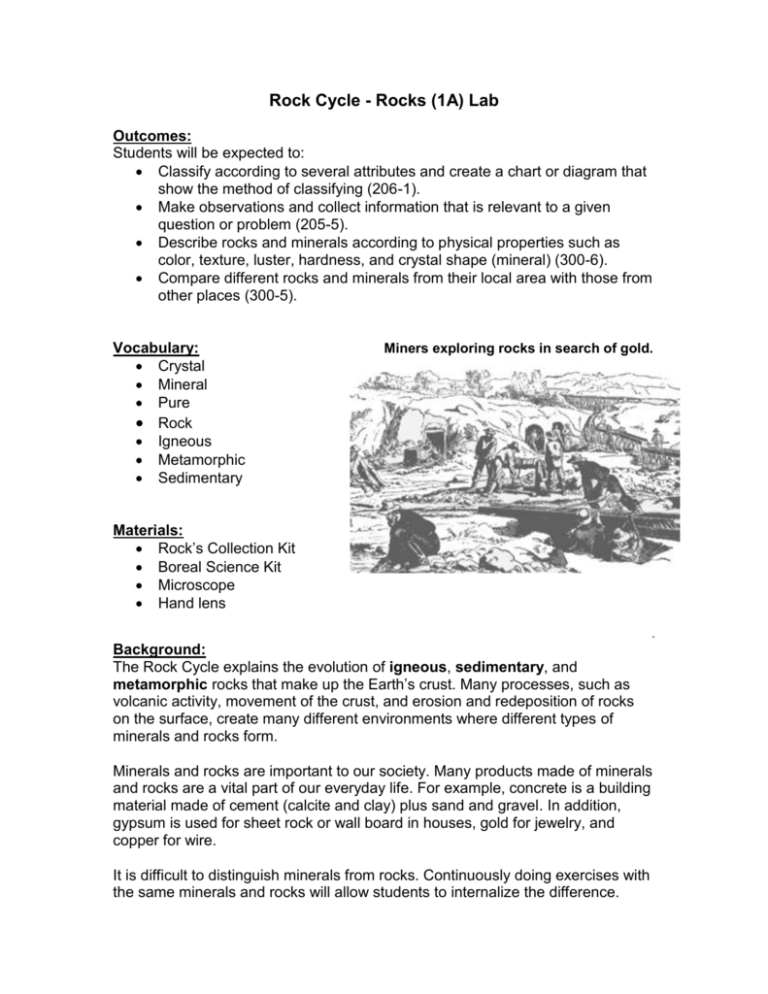Rock Cycle - Rocks (1A) Lab
advertisement

Rock Cycle - Rocks (1A) Lab Outcomes: Students will be expected to: Classify according to several attributes and create a chart or diagram that show the method of classifying (206-1). Make observations and collect information that is relevant to a given question or problem (205-5). Describe rocks and minerals according to physical properties such as color, texture, luster, hardness, and crystal shape (mineral) (300-6). Compare different rocks and minerals from their local area with those from other places (300-5). Vocabulary: Crystal Mineral Pure Rock Igneous Metamorphic Sedimentary Miners exploring rocks in search of gold. Materials: Rock’s Collection Kit Boreal Science Kit Microscope Hand lens . Background: The Rock Cycle explains the evolution of igneous, sedimentary, and metamorphic rocks that make up the Earth’s crust. Many processes, such as volcanic activity, movement of the crust, and erosion and redeposition of rocks on the surface, create many different environments where different types of minerals and rocks form. Minerals and rocks are important to our society. Many products made of minerals and rocks are a vital part of our everyday life. For example, concrete is a building material made of cement (calcite and clay) plus sand and gravel. In addition, gypsum is used for sheet rock or wall board in houses, gold for jewelry, and copper for wire. It is difficult to distinguish minerals from rocks. Continuously doing exercises with the same minerals and rocks will allow students to internalize the difference. Engage: Review the differences of rocks and minerals. A Mineral is: -a pure substance (made of same substance) -some have crystals - usually pretty -usually have a shape -color is usually the same -no fossils A Rock is: -more than one mineral -not a single crystals -not usually as pretty -no definite shape -color is not the same -some have fossils Explore: Give each group of students a bag of minerals and rocks. Instruct students to group the specimens into the following 3 piles: ROCKS - specimens that have the characteristics of rocks discussed in Pre Lab MINERALS - specimens that have the characteristics of minerals, discussed in Pre Lab DON'T KNOW - specimens that students cannot tell classify Give the students as much time as they need to examine the specimens. Encourage them to use a microscope or a hand lens. If you are using the Rock Collection (Rock Box), you have the following rocks in the container: Igneous Rocks: 1. Granite 2. Rhyolite 3. Pumice 4. Basalt 5. Obsidian Metamorphic Rocks: 5. Slate 6. Gneiss 7. Marble 8. Quartzite Sedimentary Rocks: 9. Shale 10. Limestone 11. Sandstone The following Minerals are included in the Boreal Laboratories Science Kit: 1. Pyrite 2. Pyrite 3. Magnetite 4. Grossular 5. Leucite 6. Bixbyute 7. Pyrite 8. Pyrite 9. Almandine 10. Rutile 11.Vesuvianite 12. Zircon 13. Boleite 14. Apophyllite 15. Beryl 16.Fluorapatite 17. Dolomite 18. Dolomite 19. Corundum 20. Calcite 21. Elbaite 22. Quartz 23. Quartz 24. Topaz 25. Danburite 26. Barite 27. Aragonite 28. Augite 29. Orthoclase 30. Glauberite 31. Diopside 32. Staurolite 33. Epidote 34. Gypsum 35. Microcline 36. Kyanite Explain: Go around the room and ask them if the specimens fit the characteristics of rocks or minerals. Make sure they are aware of the difficulties in the classification. Repeat the meaning of the characteristics many times, as they are hard for the students to understand and remember. Encourage your students that they should classify the specimens in the "DON'T KNOW" group into either the mineral or rock groups. If they cannot classify some of them, leave them in the "DON’T KNOW" pile. Sometimes even geologists cannot identify a rock without using a microscope. Apply: As a class consider the rocks and minerals in this more natural state, compared to when they are worked over for commercial use. Consider: Pumice - rock to soaps. Granite – rock to counter top. Marble – rock to floor tiles. Limestone – rock to roads. Slate – rock to blackboards. Etc. Extend: Introduce the terms igneous rocks, sedimentary rocks, and metamorphic rocks.. Concentrate especially on the environments of each type of rock. Explain that igneous rocks are "hot" rocks; sedimentary rocks are "cool or wet" rocks; and metamorphic rocks are "changed" rocks. There are many different types of igneous rocks. However, they all were once melted and have since cooled down. Igneous rocks look different because of two factors: (1) they are cooled at different rates and (2) the "Mother" Magma (original melted rock) was different. These two factors create many different types of igneous rocks. Sedimentary rocks are formed in 2 major ways: (1) clastic material (pieces of other rocks or fragments of skeletons) cemented together, and (2) chemical means (usually precipitation). Usually sedimentary rocks are associated with water (erosion, settling, and cemented together). However, other sedimentary environments include wind erosion, and glacial movement. Metamorphic rocks were either igneous, sedimentary, or other metamorphic rocks that were changed. They were changed by great pressures and temperatures inside the earth. The temperatures were not enough to melt the rock, otherwise it would be igneous. The pressures were not enough to break the rock, otherwise it would be sedimentary. The conditions were just enough to change the chemical make up of the rock by forcing the elements to "exchange partners".





